2003 FORD SUPER DUTY warning light
[x] Cancel search: warning lightPage 1 of 64
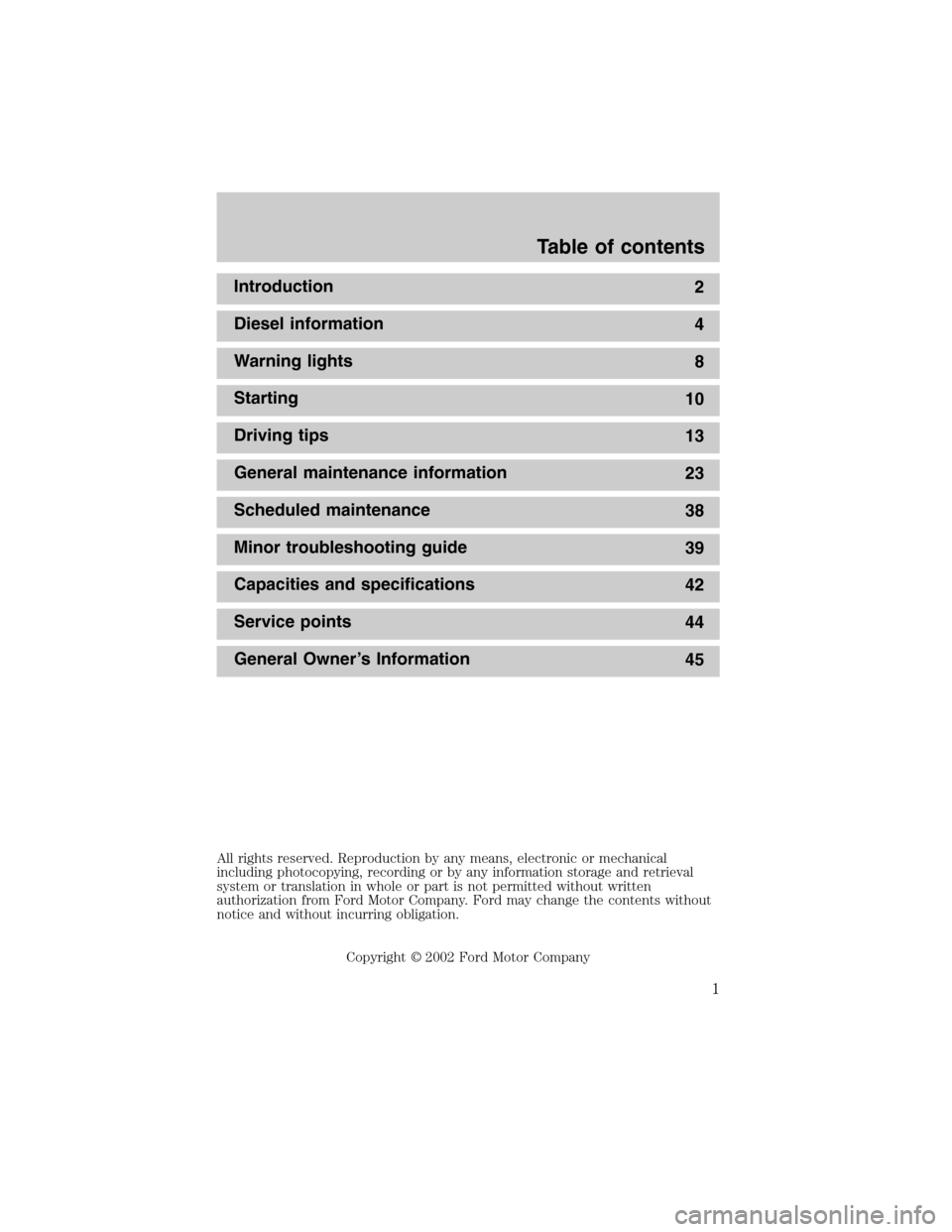
Introduction
2
Diesel information
4
Warning lights
8
Starting
10
Driving tips
13
General maintenance information
23
Scheduled maintenance
38
Minor troubleshooting guide
39
Capacities and specifications
42
Service points
44
General Owner’s Information
45
All rights reserved. Reproduction by any means, electronic or mechanical
including photocopying, recording or by any information storage and retrieval
system or translation in whole or part is not permitted without written
authorization from Ford Motor Company. Ford may change the contents without
notice and without incurring obligation.
Copyright © 2002 Ford Motor Company
Table of contents
1
Page 6 of 64
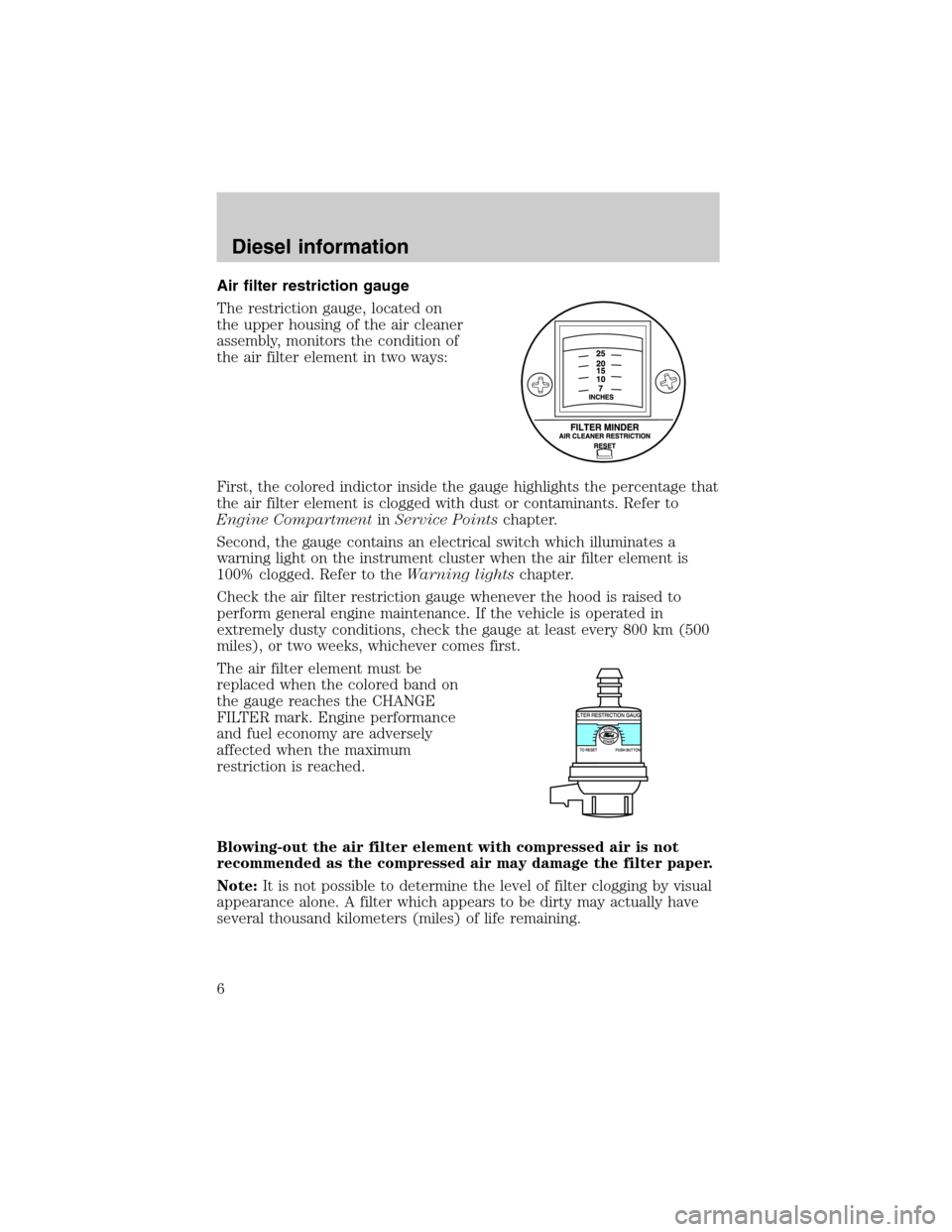
Air filter restriction gauge
The restriction gauge, located on
the upper housing of the air cleaner
assembly, monitors the condition of
the air filter element in two ways:
First, the colored indictor inside the gauge highlights the percentage that
the air filter element is clogged with dust or contaminants. Refer to
Engine CompartmentinService Pointschapter.
Second, the gauge contains an electrical switch which illuminates a
warning light on the instrument cluster when the air filter element is
100% clogged. Refer to theWarning lightschapter.
Check the air filter restriction gauge whenever the hood is raised to
perform general engine maintenance. If the vehicle is operated in
extremely dusty conditions, check the gauge at least every 800 km (500
miles), or two weeks, whichever comes first.
The air filter element must be
replaced when the colored band on
the gauge reaches the CHANGE
FILTER mark. Engine performance
and fuel economy are adversely
affected when the maximum
restriction is reached.
Blowing-out the air filter element with compressed air is not
recommended as the compressed air may damage the filter paper.
Note:It is not possible to determine the level of filter clogging by visual
appearance alone. A filter which appears to be dirty may actually have
several thousand kilometers (miles) of life remaining.
Diesel information
6
Page 7 of 64
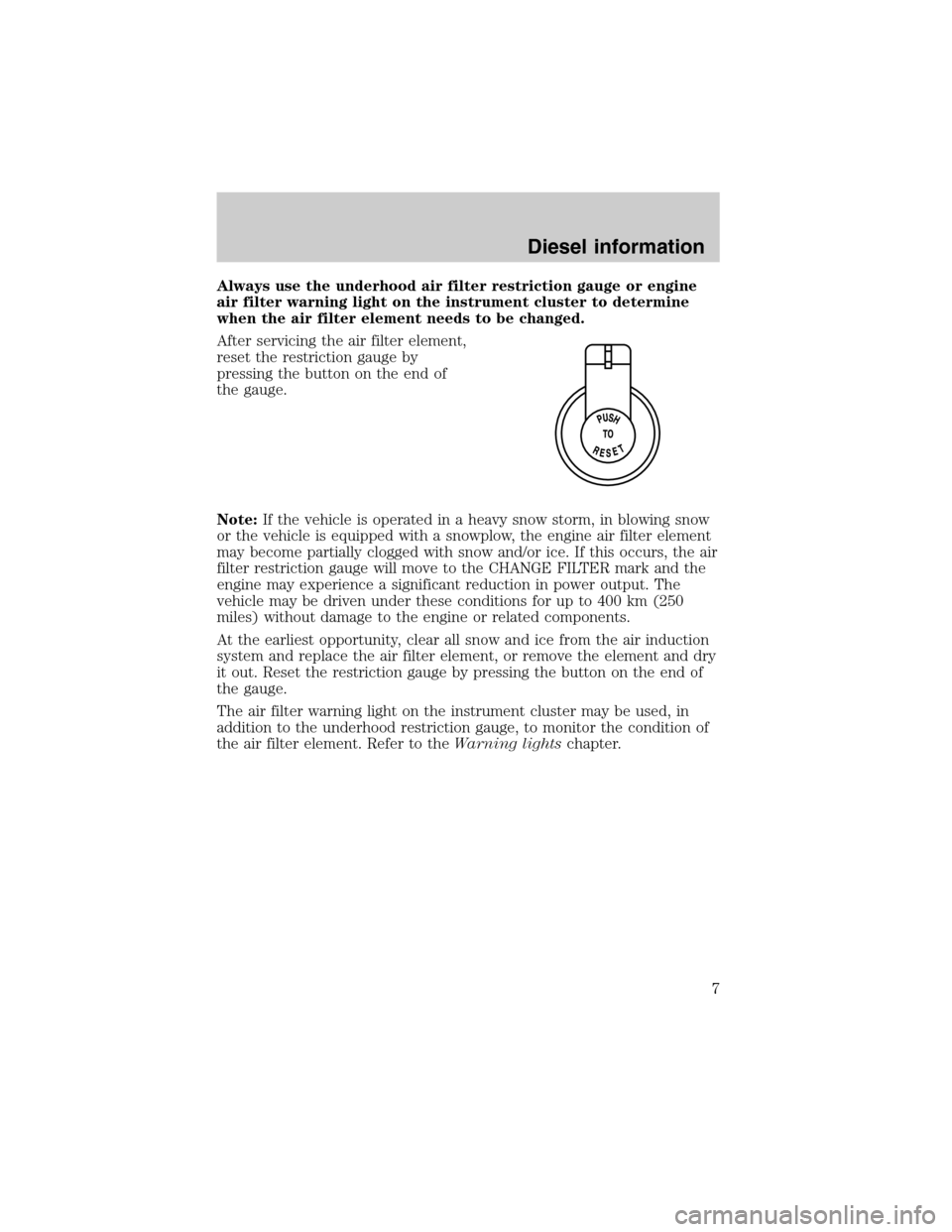
Always use the underhood air filter restriction gauge or engine
air filter warning light on the instrument cluster to determine
when the air filter element needs to be changed.
After servicing the air filter element,
reset the restriction gauge by
pressing the button on the end of
the gauge.
Note:If the vehicle is operated in a heavy snow storm, in blowing snow
or the vehicle is equipped with a snowplow, the engine air filter element
may become partially clogged with snow and/or ice. If this occurs, the air
filter restriction gauge will move to the CHANGE FILTER mark and the
engine may experience a significant reduction in power output. The
vehicle may be driven under these conditions for up to 400 km (250
miles) without damage to the engine or related components.
At the earliest opportunity, clear all snow and ice from the air induction
system and replace the air filter element, or remove the element and dry
it out. Reset the restriction gauge by pressing the button on the end of
the gauge.
The air filter warning light on the instrument cluster may be used, in
addition to the underhood restriction gauge, to monitor the condition of
the air filter element. Refer to theWarning lightschapter.
Diesel information
7
Page 8 of 64
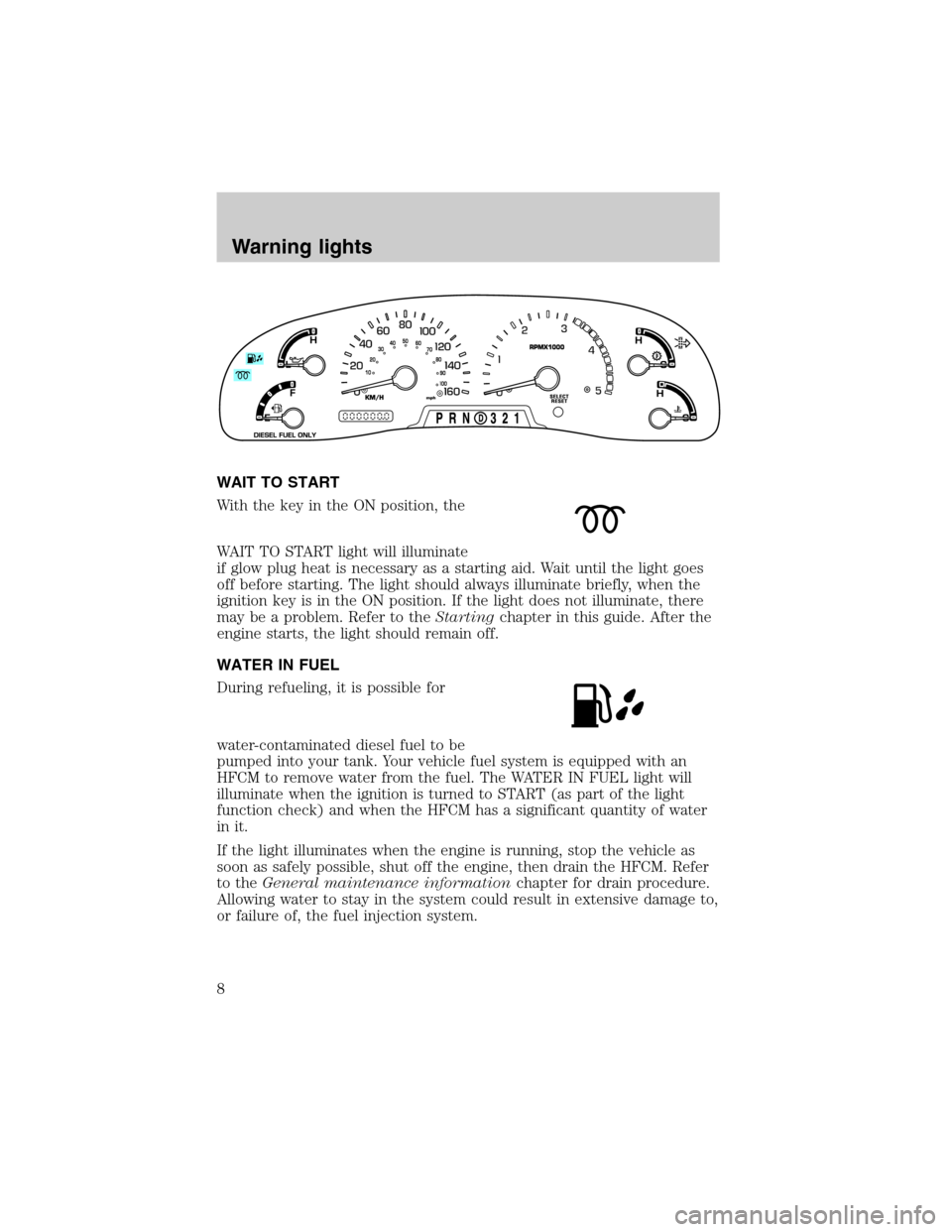
WAIT TO START
With the key in the ON position, the
WAIT TO START light will illuminate
if glow plug heat is necessary as a starting aid. Wait until the light goes
off before starting. The light should always illuminate briefly, when the
ignition key is in the ON position. If the light does not illuminate, there
may be a problem. Refer to theStartingchapter in this guide. After the
engine starts, the light should remain off.
WATER IN FUEL
During refueling, it is possible for
water-contaminated diesel fuel to be
pumped into your tank. Your vehicle fuel system is equipped with an
HFCM to remove water from the fuel. The WATER IN FUEL light will
illuminate when the ignition is turned to START (as part of the light
function check) and when the HFCM has a significant quantity of water
in it.
If the light illuminates when the engine is running, stop the vehicle as
soon as safely possible, shut off the engine, then drain the HFCM. Refer
to theGeneral maintenance informationchapter for drain procedure.
Allowing water to stay in the system could result in extensive damage to,
or failure of, the fuel injection system.
Warning lights
8
Page 9 of 64

Do not drain the HFCM while the engine is running. Fuel may
ignite if the separator is drained while the engine is running or
the vehicle is moving.
ENGINE AIR FILTER
The engine air filter warning light
illuminates when the air filter
restriction gauge reaches the
CHANGE FILTER mark.
The vehicle may be driven with the engine air filter warning light
illuminated for up to 400 km (250 miles) without damaging the engine or
related components. However, the air filter elementmustbe replaced at
the earliest opportunity. Refer toAir filter restriction gaugein the
Diesel informationchapter for more information.
Warning lights
9
Page 11 of 64

5. After the engine starts, allow it to idle for about 15 seconds. (Do not
increase engine speed until the oil pressure gauge indicates normal
pressure.)
STOPPING THE ENGINE
Turn the ignition to OFF. To prolong engine life (after extended high
speed or maximum GVW operation), it is recommended that a hot engine
be allowed to operate at low idle for about 7–10 minutes which would
allow sufficient time for the turbocharged engine to cool down.
COLD WEATHER OPERATION
Changing to a lighter grade engine oil also makes starting easier under
these conditions. Refer toEngine oil specificationsin theGeneral
maintenance informationchapter.
At temperatures below–7°C (20°F), Number 2–D Diesel fuel may
thicken enough to clog the fuel filter. Your vehicle is equipped with an
HFCM which acts as a fuel filter/heater/water separator to keep the wax
melted which will help prevent fuel filter clogging. However, if the engine
starts but stalls after a short time and will not restart, the fuel filter(s)
may be clogged. For best results in cold weather, use Number 1–D Diesel
fuel or“winterized”Number 2–D Diesel fuel which has an additive to
minimize wax formation.
Your vehicle is also equipped with a bypass relief valve, located on the
fuel control module, which provides fuel flow to the engine if the fuel
pickup should become plugged by ice or wax. To allow this bypass valve
to function and avoid engine fuel starvation, it is recommended that,
during cold weather operation 0°C (32°F) or below, the fuel level in your
tank should not be allowed to drop below 1/4 full. This will help prevent
air from entering the fuel system and stalling the engine.
In cold weather below 0°C (32°F) your Diesel engine will slowly increase
to a higher idle speed if left idling in P (Park). As the engine warms-up,
the engine sound level will decrease due to the activation of
PCM-controlled sound reduction features.
Operation in snow
Vehicle operation in heavy snowfall or in dry loose snow that may swirl
around the front of the vehicle may feed excessive amounts of snow into
the air intake system. This could plug the air cleaner with snow and
cause the engine to stall.
Refer toAir filter restriction gaugein theDiesel informationchapter
and Engine air filter in theWarning lightschapter for more information.
Starting
11
Page 25 of 64
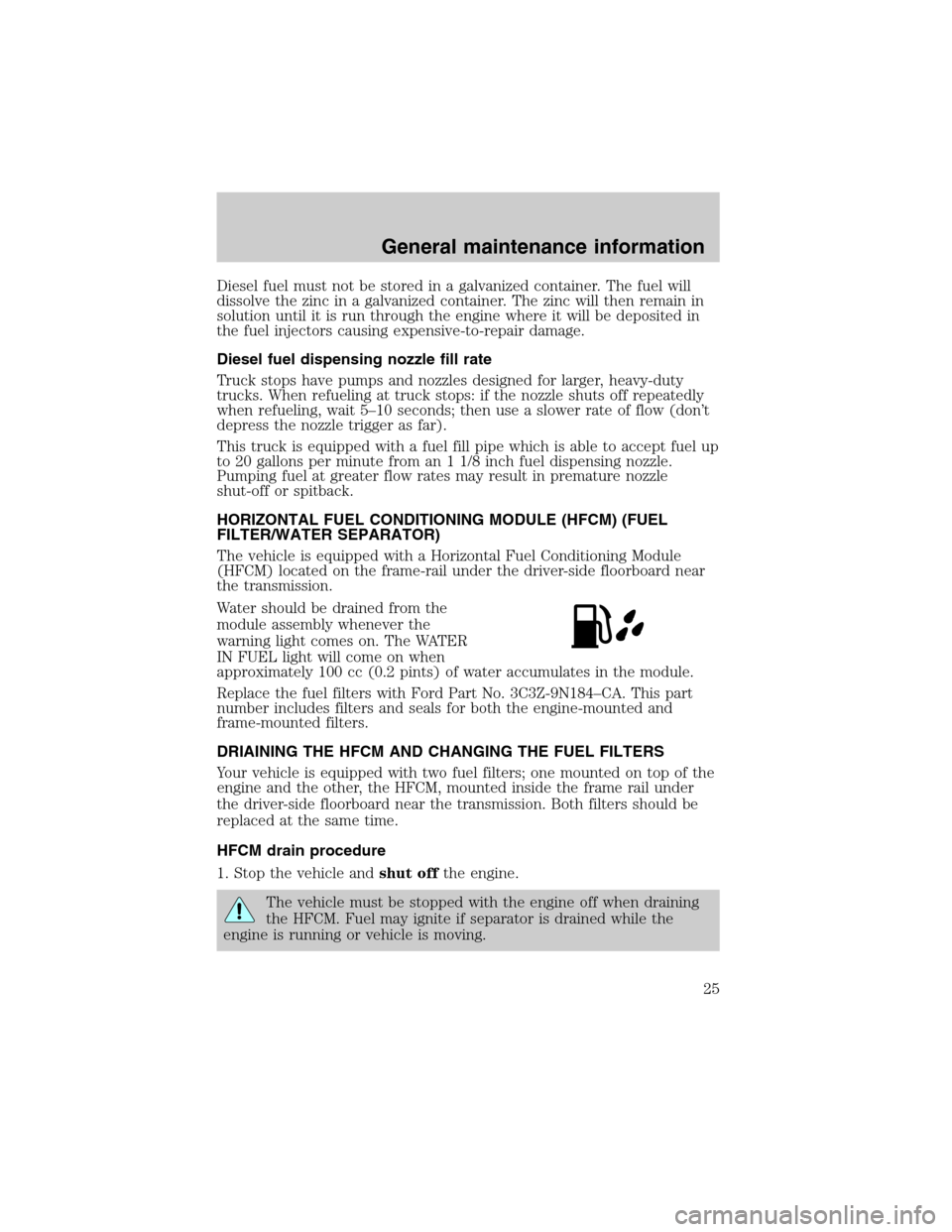
Diesel fuel must not be stored in a galvanized container. The fuel will
dissolve the zinc in a galvanized container. The zinc will then remain in
solution until it is run through the engine where it will be deposited in
the fuel injectors causing expensive-to-repair damage.
Diesel fuel dispensing nozzle fill rate
Truck stops have pumps and nozzles designed for larger, heavy-duty
trucks. When refueling at truck stops: if the nozzle shuts off repeatedly
when refueling, wait 5–10 seconds; then use a slower rate of flow (don’t
depress the nozzle trigger as far).
This truck is equipped with a fuel fill pipe which is able to accept fuel up
to 20 gallons per minute from an 1 1/8 inch fuel dispensing nozzle.
Pumping fuel at greater flow rates may result in premature nozzle
shut-off or spitback.
HORIZONTAL FUEL CONDITIONING MODULE (HFCM) (FUEL
FILTER/WATER SEPARATOR)
The vehicle is equipped with a Horizontal Fuel Conditioning Module
(HFCM) located on the frame-rail under the driver-side floorboard near
the transmission.
Water should be drained from the
module assembly whenever the
warning light comes on. The WATER
IN FUEL light will come on when
approximately 100 cc (0.2 pints) of water accumulates in the module.
Replace the fuel filters with Ford Part No. 3C3Z-9N184–CA. This part
number includes filters and seals for both the engine-mounted and
frame-mounted filters.
DRIAINING THE HFCM AND CHANGING THE FUEL FILTERS
Your vehicle is equipped with two fuel filters; one mounted on top of the
engine and the other, the HFCM, mounted inside the frame rail under
the driver-side floorboard near the transmission. Both filters should be
replaced at the same time.
HFCM drain procedure
1. Stop the vehicle andshut offthe engine.
The vehicle must be stopped with the engine off when draining
the HFCM. Fuel may ignite if separator is drained while the
engine is running or vehicle is moving.
General maintenance information
25
Page 49 of 64

Any adverse condition should be brought to the attention of your dealer
or qualified service technician as soon as possible for the proper service
advice. The owner maintenance service checks are generally not covered
by warranties so you may be charged for labor, parts or lubricants used.
Maximum Oil Change Interval:
Normal Schedule: 7,500 miles or 6 months, whichever occurs first.
Special Operating Conditions: 5,000 miles or 6 months, see appropriate
schedule.
Check every month:
•Check function of all interior and exterior lights
•Check tires for wear and proper air pressure
•Check engine oil fluid level
•Check windshield washer solvent fluid level
•Check and drain fuel filter/water separator
Check every six months:
•Check lap/shoulder belts and seat latches for wear and function
•Check air pressure in spare tire
•Check that externally-mounted spare tire is tight (see Owner’s Guide)
•Check power steering fluid level
•Check washer spray, wiper operation and clean all wiper blades
•Check parking brake for proper operation
•Check and lubricate all hinges, latches and outside locks
•Check and lubricate door rubber weatherstrips
•Check and clean body and door drain holes
•Check safety warning lamps (brake, ABS, air bag, safety belt) for
operation
•Check cooling system fluid level and coolant strength
•Check battery connections and clean if necessary
•Check clutch fluid level, if equipped
General Owner’s Information
49